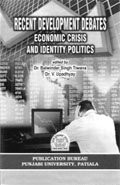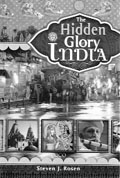|
short takes
Discussing development and culture
Target 3 Billion
by APJ Abdul Kalam & Srijan Pal Singh
Penguin. Pages xix+298. Rs 299
 Our
planet’s population has
exceeded the seven-billion mark. Out of these, more than three billion
people live "in a condition of underutilisation of talent and
resources, and deprivation," in other words, on the margins. This
book, while providing a global context to Indian conditions, takes a
comprehensive look at the socio-economic challenges that face us and
possible solutions there to. Not an easy task, if you consider the fact
that in India alone there is a mind-boggling diversity in terms of
ethnicity, languages, educational standards, economic and cultural
stratifications etc. Yet, Kalam and Singh have come up with a workable
PURA model that provides innovative solutions towards sustainable
development. The model focuses on providing urban amenities in rural
areas. For this purpose, the authors suggest various steps towards
empowering the deprived. For example, while advocating the second Green
Revolution, the authors want the focus to be on the "five-acre
farmers" rather than the 500-acre farmers. Again, they would like
infrastructure development in rural areas to be based on the principle
of benefiting the poor. This makes sense. For, if the living standards
of the most deprived are improved the overall global/national prosperity
would become that much more evenhanded and enduring. While reworking the
Gandhian concept of ideal, self-sustaining villages, the authors see
them "as action areas of social transformation." They also
advocate transformation in societal, especially governmental, attitudes:
Postings in rural areas should not be considered as
"reprimands." Indeed, the PURA model advocates eco-friendly
development wherein technology becomes a tool for more equitable
distribution of wealth, opportunities and resources; as the authors
aver, "The concept of PURA is fully achieved only when there is a
dynamic linkage between economic development and social and cultural
transformation in real time and in a seamless manner." An extremely
well thought out and implementable model. This book is invaluable for
social scientists, policy makers and serious students of developmental
economics. Our
planet’s population has
exceeded the seven-billion mark. Out of these, more than three billion
people live "in a condition of underutilisation of talent and
resources, and deprivation," in other words, on the margins. This
book, while providing a global context to Indian conditions, takes a
comprehensive look at the socio-economic challenges that face us and
possible solutions there to. Not an easy task, if you consider the fact
that in India alone there is a mind-boggling diversity in terms of
ethnicity, languages, educational standards, economic and cultural
stratifications etc. Yet, Kalam and Singh have come up with a workable
PURA model that provides innovative solutions towards sustainable
development. The model focuses on providing urban amenities in rural
areas. For this purpose, the authors suggest various steps towards
empowering the deprived. For example, while advocating the second Green
Revolution, the authors want the focus to be on the "five-acre
farmers" rather than the 500-acre farmers. Again, they would like
infrastructure development in rural areas to be based on the principle
of benefiting the poor. This makes sense. For, if the living standards
of the most deprived are improved the overall global/national prosperity
would become that much more evenhanded and enduring. While reworking the
Gandhian concept of ideal, self-sustaining villages, the authors see
them "as action areas of social transformation." They also
advocate transformation in societal, especially governmental, attitudes:
Postings in rural areas should not be considered as
"reprimands." Indeed, the PURA model advocates eco-friendly
development wherein technology becomes a tool for more equitable
distribution of wealth, opportunities and resources; as the authors
aver, "The concept of PURA is fully achieved only when there is a
dynamic linkage between economic development and social and cultural
transformation in real time and in a seamless manner." An extremely
well thought out and implementable model. This book is invaluable for
social scientists, policy makers and serious students of developmental
economics.
 Recent Development Debates Recent Development Debates
Ed. Balwinder Singh Tiwana & V. Upadhyay
Punjabi University. Pages: xi+378. Rs 400
This
is a collection of papers on
various aspects of the Indian economy’s development, including
identity politics and the impact of the global economic crisis. In fact,
the ongoing global crisis has its roots in the first Oil Shock of the
1990s. It took a heavy toll of the ‘Asian Tiger’ economies, even as
it had adversely impacted the Western and Japanese economies. This led
to the transformation of dominant development theories – giving birth
to two broad streams, viz., the one-recipe-fits-all approach of the
Washington Consensus and the other looking at alternate methods seeking
to modify the entire development discourse. This volume also takes a
look at how, and why, the mismatch between policy formulations and
peoples’ aspirations should be avoided. However, it would have been
interesting if the Chinese economy’s impressive performance was
examined against the backdrop of the global slowdown. However, this
volume is a valuable addition to the national discourse on development
economics.
 The Hidden Glory of India The Hidden Glory of India
by Steven J. Rosen. Jaico. Pages 191. Rs 395
India
never stops surprising Indophiles. Its mind-boggling ethnic, linguistic,
sub-cultural and regional variety has proved to be both challenging and
inspiring to various historians and social scientists. Often, while
talking of pluralism, we tend to divide the society into broad swathes
of religious spectra, while forgetting that each religion is further
subdivided into various sects and denominations. Hinduism is a prime
example, while discussing which we lose sight of the fact that
Vaishnavism forms its single largest denomination. This calendar-art
style beautifully illustrated book takes a brief look at Vaishnava
literature, precepts and practices, including its dominant gods —
Vishnu, Krishna and Rama. An informative volume.
|